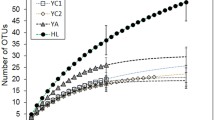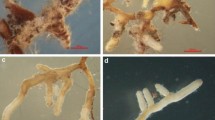Abstract
Large forest areas of South-East Asia, are dominated by the Dipterocarpaceae tree family, which contains many important timber species. Unlike many other tropical trees, Dipterocarpaceae rely on ectomycorrhizal (ECM) root symbiosis for their mineral nutrition. This study aims to document the richness and community composition of ECM fungi in a dry deciduous forest in Thailand. Combining morphological and molecular identification methods revealed 69 species of ECM fungi that belong to 17 phylogenetic lineages. The /russula-lactarius, /tomentella-thelephora, /sordariales, /sebacina and /cantharellus lineages were the most species-rich. The fungal richness is comparable to other tropical rain forest sites, but the phylogenetic community structure has elements of both tropical and temperate ecosystems. Unlike tropical rain forests, the Cenococcum geophilum complex was one of the most frequent fungal taxa that had a relatively high ITS genetic diversity over the small sampling area. This study provides the first snapshot insight into the fungal community of dry dipterocarp forests. However, it is necessary to broaden the spatial and temporal scales of sampling to improve our understanding of the below-ground relations of dry and humid tropical forests.


Similar content being viewed by others
References
Abarenkov K, Nilsson RH, Larsson K-H, Alexander IJ, Eberhardt U, Erland S, Høiland K, Kjøller R, Larsson E, Pennanen T, Sen R, Taylor AFS, Tedersoo L, Ursing B, Vrålstad T, Liimatainen K, Peintner U, Kõljalg U (2010a) The UNITE database for molecular identification of fungi—recent updates and future perspectives. New Phytol 186:281–285
Abarenkov K, Tedersoo L, Nilsson RH, Vellak K, Saar I, Veldre V, Parmasto E, Prous M, Aan A, Ots M, Kurina O, Ostonen I, Jõgeva J, Halapuu S, Põldmaa K, Toots M, Truu J, Larsson K-H, Kõljalg U (2010b) PlutoF—a web based workbench for ecological and taxonomic research with an online implementation for fungal ITS sequences. Evol Bioinform 6:189–196
Agerer R (1987–2002) Colour atlas of ectomycorrhizae. Einhorn-Verlag, Schwäbisch Gmünd, Germany
Bahram M, Põlme S, Kõljalg U, Tedersoo L (2011) A single European aspen (Populus tremula) tree individual may potentially harbour dozens of Cenococcum geophilum ITS genotypes and hundreds of species of ectomycorrhizal fungi. FEMS Microbiol Ecol 75:313–320
Begerow D, Nilsson RH, Unterseher M, Maier W (2010) Current state and perspectives of fungal DNA barcoding and rapid identification procedures. Appl Microbiol Biotechnol 87:99–108
Boehm EWA, Mugambi GK, Miller AN, Huhndorf SM, Marincowitz S, Spatafora JW, Schoch CL (2009) A molecular phylogenetic reappraisal of the Hysteriaceae, Mytilinidiacae and Gloniaceae (Pleosporomycetidae, Dothideomycetes) with key to world species. Stud Mycol 64:49–83
Brearley FQ, Press MC, Scholes JD (2003) Nutrients obtained from leaf litter can improve the growth of dipterocarp seedlings. New Phytol 160:101–110
Brundrett MC (2009) Mycorrhizal associations and other means of nutrition of vascular plants: understanding global diversity of host plants by resolving conflicting information and developing reliable means of diagnosis. Plant Soil 320:37–77
Bruns TD, Bidartondo MI, Taylor DL (2002) Host specificity in ectomycorrhizal communities: what do the exceptions tell us? Integr Comp Biol 42:352–359
Buscardo E, Rodríguez-Echeverría S, Martín MP, De Angelis P, Pereiria JS, Freitas H (2010) Impact of wildfire return interval on the ectomycorrhizal resistant propagules communities of a mediterranean open forest. Fungal Biol 114:628–636
Buyck B, Thoen D, Watling R (1996) Ectomycorrhizal fungi in the Congo-Guinea region. Proc R Soc Edinb 104B:313–333
Chalermpongse A (1993) Biodiversity of mycorrhizal fungi in the dipterocarp forests of Thailand. In: Anon. (eds) BIO-REFOR: proceedings of Tsukuba-Workshop, pp 143–153. BIO-REFOR, IUFRO-SPDC, Tsukuba Science City, Japan
Chen DM, Cairney JWG (2002) Investigation of the influence of prescribed burning on ITS profiles of ectomycorrhizal and other soil fungi at three Australian sclerophyll forest sites. Mycol Res 106:532–540
Corner EJH (1968) A monograph of Thelephora. Nova Hedw 27:1–110
Diédhiou AG, Selosse MA, Galiana A, Diabaté M, Dreyfus B, Bâ AM, De Faria SM, Béna G (2010) Multi-host ectomycorrhizal fungi are predominant in a Guinean tropical rainforest and shared between canopy trees and seedlings. Environ Microbiol 12:2219–2232
Douhan GW, Martin DP, Rizzo DM (2007) Using the putative asexual fungus Cenococcum geophilum as a model to test how species concepts influence recombination analyses using sequence data from multiple loci. Curr Genet 52:191–201
Gardes M, Bruns TD (1996) Community structure of ectomycorrhizal fungi in a Pinus muricata forest: above-and below-ground views. Can J Bot 74:1572–1583
Girlanda M, Ghignone S, Luppi AM (2002) Diversity of sterile root-associated fungi of two Mediterranean plants. New Phytol 155:481–498
Ishida TA, Nara K, Hogetsu T (2007) Host effects on ectomycorrhizal fungal communities: insight from eight host species in mixed conifer-broadleaf forests. New Phytol 174:430–440
Katoh K, Toh H (2008) Recent developments in the MAFFT multiple sequence alignment program. Brief Bioinform 9:286–298
Lee SS, Patahayah M (2003) Host specificity of dipterocarp ectomycorrhizal fungi. In: Aminah H, Ani S, Sim HC, Krishnapillay B (eds) Proceedings of the Seventh Round-Table Conference on Dipterocarps. Asia Pacific Association of Forestry Research Institutions, Kuala Lumpur, Malaysia, 7–10 October 2002, pp 214–217
Lee SS, Patahayah M, Lapeyrie F (2002) Exotic vs. indigenous ectomycorrhizal fungi for inoculation of dipterocarps. In: Ishii K, Masumori M, Suzuki K (eds) BIO-REFOR: Proceedings of Tokyo-Workshop, BIO-REFOR, IUFRO-SPDC, pp 84–87
LoBuglio KF (1999) Cenococcum. In: Cairney JWG, Chambers SM (eds) Ectomycorrhizal fungi: key genera in profile. Springer, Berlin, pp 187–309
May TW, Simpson JA (1997) Fungal diversity and ecology in eucalypt ecosystems. In: Williams J, Woinarski J (eds) Eucalypt ecology: individuals to ecosystems. Cambridge University Press, Cambridge, pp 246–277
Panwittayakul C, Srikampol Y (2006) Taxonomy study of family Rubiaceae at Phitsanulok wildlife development and extensive conservation station. Dissertation, Naresuan University (in Thai)
Peay KG, Kennedy PG, Davies SJ, Tan S, Bruns TD (2010) Potential link between plant and fungal distributions in a dipterocarp rainforest: community and phylogenetic structure of tropical ectomycorrhizal fungi across a plant and soil ecotone. New Phytol 185:529–542
Ramanankierana N, Ducousso M, Rakotoarimanga N, Prin Y, Thioulouse J (2006) Arbuscular mycorrhizas and ectomycorrhizas of Uapaca bojeri L (Euphorbiaceae): sporophore diversity, patterns of root colonization, and effects on seedling growth and soil microbial catabolic diversity. Mycorrhiza 17:195–208
Rinaldi AC, Comadini O, Kuyper TW (2008) Ectomycorrhizal fungal diversity: separating the wheat from the chaff. Fung Div 33:1–45
Riviere T, Diedhiou AG, Diabate M, Senthilarasu G, Natarajan K, Verbeken A, Buyck B, Dreyfus B, Bena G, Ba AM (2007) Genetic diversity of ectomycorrhizal basidiomycetes from African and Indian tropical forests. Mycorrhiza 17:415–428
Sims K, Watling R, de la Cruz R, Jeffries P (1997) Ectomycorrhizal fungi of the Philippines: a preliminary survey and notes on the geographic biodiversity of the Sclerodermatales. Biodivers Conserv 6:45–58
Sirikantaramas S, Sugioka N, Lee SS, Mohamed LA, Lee HS, Szmidt AE, Yamazaki T (2003) Molecular identification of ectomycorrhizal fungi associated with Dipterocarpaceae. Tropics 13:69–77
Smith ME, Douhan GW, Rizzo DM (2007) Ectomycorrhizal community structure in a xeric Quercus woodland based on rDNA sequence analysis of sporocarps and pooled roots. New Phytol 174:847–863
Smith ME, Henkel TW, Aime MC, Fremier AK, Vilgalys R (2011) Ectomycorrhizal fungal diversity and community structure on three co-occurring leguminous canopy tree species in a Neotropical rainforest. New Phytol 192:699–712
Stamatakis A, Hoover P, Rougemont J (2008) A rapid bootstrap algorithm for the RAxML web-servers. Syst Biol 75:758–771
Suvi T, Tedersoo L, Abarenkov K, Gerlach J, Beaver K, Kõljalg U (2010) Mycorrhizal symbionts of Pisonia grandis and P. sechellarum in Seychelles: identification of mycorrhizal fungi and description of new Tomentella species. Mycologia 102:522–533
Taylor AFS (2008) Recent advances in our understanding of fungal ecology. Coolia 51:197–212
Taylor AFS, Alexander IJ (2005) The ectomycorrhizal symbiosis: life in the real world. Mycologist 19:102–112
Tedersoo L, Nara K (2010) General latitudinal gradient of biodiversity is reversed in ectomycorrhizal fungi. New Phytol 185:351–354
Tedersoo L, Suvi T, Larsson E, Kõljalg U (2006) Diversity and community structure of ectomycorrhizal fungi in a wooded meadow. Mycol Res 110:734–748
Tedersoo L, Suvi T, Beaver K, Kõljalg U (2007) Ectomycorrhizal fungi of the Seychelles: diversity patterns and host shifts from the native Vateriopsis seychellarum (Dipterocarpaceae) and Intsia bijuga (Caesalpiniaceae) to the introduced Eucalyptus robusta (Myrtaceae), but not Pinus caribea (Pinaceae). New Phytol 175:321–333
Tedersoo L, Jairus T, Horton BM, Abarenkov K, Suvi T, Saar I, Kõljalg U (2008) Strong host preference of ectomycorrhizal fungi in a Tasmanian wet sclerophyll forest as revealed by DNA barcoding and taxon-specific primers. New Phytol 180:479–490
Tedersoo L, May TW, Smith ME (2010a) Ectomycorrhizal lifestyle in fungi: global diversity, distribution, and evolution of phylogenetic lineages. Mycorrhiza 20:217–263
Tedersoo L, Nilsson RH, Abarenkov K, Jairus T, Sadam A, Saar I, Bahram M, Bechem E, Chuyong G, Kõljalg U (2010b) 454 Pyrosequencing and Sanger sequencing of tropical mycorrhizal fungi provide similar results but reveal substantial methodological biases. New Phytol 188:291–301
Tedersoo L, Sadam A, Zambrano M, Valencia R, Bahram M (2010c) Low diversity and high host preference of ectomycorrhizal fungi in Western Amazonia, a neotropical biodiversity hotspot. ISME J 4:465–471
Tedersoo L, Bahram M, Jairus T, Bechem E, Chinoya S, Mpumba R, Leal M, Randrianjohany E, Razafimandimbison S, Sadam A, Naadel T, Kõljalg U (2011) Spatial structure and the effects of host and soil environments on communities of ectomycorrhizal fungi in wooded savannas and rain forests of Continental Africa and Madagascar. Mol Ecol 20:3071–3080
Trappe JM (1962) Cenococcum graniforme—its distribution, ecology, mycorrhiza and inherent variation. PhD thesis, University of Washington, Seattle, Washington
Watling R, Lee SS (1995) Ectomycorrhizal fungi associated with members of the Dipterocarpaceae in Peninsular Malaysia. J Trop For Sci 7:657–669
Watling R, Lee SS (2007) Mycorrhizal mycodiversity in Malaysia. In: Jones EBG, Hyde KD, Vikineswary S (eds) Malaysian fungal diversity. Mushroom Research Centre, University of Malaya and Ministry of Natural Resources and Environment, Malaysia, pp 201–219
Watling R, Lee SS, Turnbull E (2002) The occurrence and distribution of putative ectomycorrhizal basidiomycetes in a regenerating south-east Asian rainforest. In: Watling R, Frankland JC, Ainsworth AM, Isaac S, Robinson CH (eds) Tropical mycology vol. 1. Macromycetes, CAB International, pp 25–43
Yuwa-Amornpitak T, Vichitsoonthonkul T, Tanticharoen M, Cheevadhanarak S, Ratchadawong S (2006) Diversity of ectomycorrhizal fungi on Dipterocarpaceae in Thailand. J Biol Sci 6:1059–1064
Acknowledgments
We thank the head of Wildlife Conservation, Development and Extension station, Phitsanulok, Mr. Sawarng Sitawan who facilitated the field study. This study was funded by NRCT grant to CP; ESF grants 7434, 8235, 9286, and FIBIR to SP, LT and UK.
Author information
Authors and Affiliations
Corresponding author
Additional information
Cherdchai Phosri and Sergei Põlme contributed equally to this work.
Rights and permissions
About this article
Cite this article
Phosri, C., Põlme, S., Taylor, A.F.S. et al. Diversity and community composition of ectomycorrhizal fungi in a dry deciduous dipterocarp forest in Thailand. Biodivers Conserv 21, 2287–2298 (2012). https://doi.org/10.1007/s10531-012-0250-1
Received:
Accepted:
Published:
Issue Date:
DOI: https://doi.org/10.1007/s10531-012-0250-1




